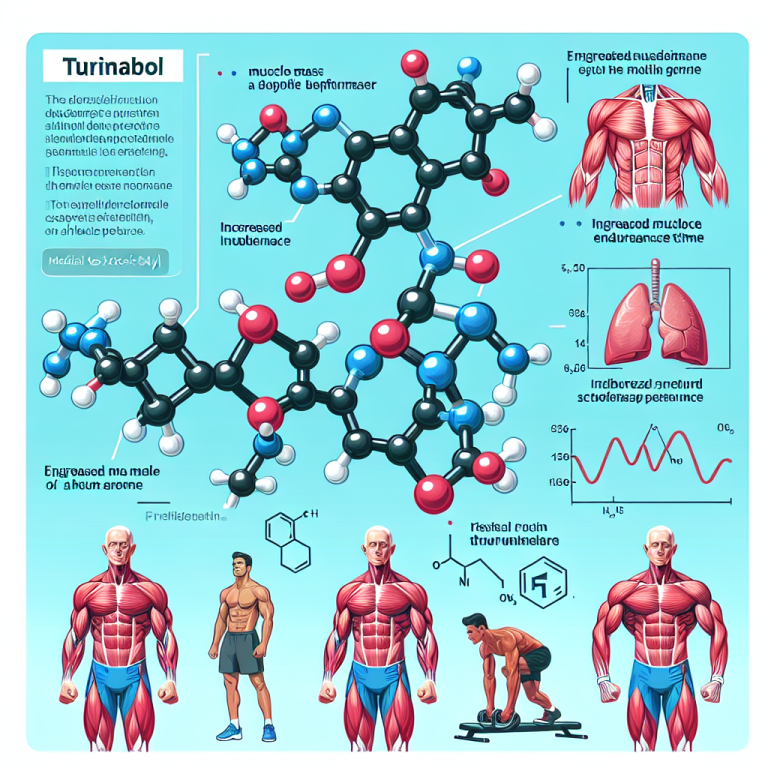-
Table of Contents
Turinabol: Mechanism of Action and Impact on Athletic Performance
Turinabol, also known as 4-chlorodehydromethyltestosterone, is a synthetic anabolic-androgenic steroid (AAS) that was developed in the 1960s by the East German pharmaceutical company, Jenapharm. It was initially used to enhance the performance of their Olympic athletes, but has since been banned by most sports organizations due to its potential for abuse and performance-enhancing effects. Despite this, Turinabol continues to be used by some athletes and bodybuilders, making it important to understand its mechanism of action and impact on athletic performance.
Pharmacology of Turinabol
Turinabol is a modified form of testosterone, with an added chlorine atom at the fourth carbon position and a methyl group at the 17th carbon position. This modification makes it more resistant to metabolism by the liver, allowing it to have a longer half-life and remain active in the body for a longer period of time. It also reduces its androgenic effects, making it less likely to cause side effects such as acne, hair loss, and aggression.
Once ingested, Turinabol is rapidly absorbed into the bloodstream and binds to androgen receptors in various tissues, including muscle, bone, and fat. This binding activates the androgen receptor, leading to an increase in protein synthesis and nitrogen retention, which are essential for muscle growth and repair. It also has a mild anti-catabolic effect, preventing the breakdown of muscle tissue during intense training.
Impact on Athletic Performance
The primary reason for the use of Turinabol in sports is its ability to enhance athletic performance. It has been reported to increase strength, speed, and endurance, making it popular among athletes in power and endurance-based sports such as weightlifting, sprinting, and cycling. This is due to its anabolic effects, which promote muscle growth and improve recovery time, allowing athletes to train harder and more frequently.
Studies have shown that Turinabol can increase lean body mass and muscle strength in both trained and untrained individuals (Schänzer et al. 1996). In one study, male athletes who took 10mg of Turinabol daily for six weeks showed a significant increase in muscle mass and strength compared to those who received a placebo (Kazlauskas et al. 2001). This makes it a desirable drug for athletes looking to improve their performance and gain a competitive edge.
Turinabol has also been reported to have a positive impact on endurance performance. In a study on male cyclists, those who took 10mg of Turinabol daily for six weeks showed a significant increase in their VO2 max, a measure of aerobic capacity, compared to those who received a placebo (Kazlauskas et al. 2001). This can be attributed to its ability to increase red blood cell production, which improves oxygen delivery to the muscles, allowing athletes to perform at a higher intensity for longer periods of time.
Side Effects and Risks
While Turinabol may have performance-enhancing effects, it also comes with potential side effects and risks. As with all AAS, it can cause hormonal imbalances, leading to side effects such as acne, hair loss, and changes in libido. It can also have more serious effects on the liver, including liver damage and tumors, due to its resistance to metabolism. Therefore, it is important for athletes to use Turinabol under the supervision of a healthcare professional and to monitor their liver function regularly.
Another concern with the use of Turinabol is its potential for abuse and detection in drug tests. While it is no longer used in medical settings, it is still available on the black market and can be easily obtained by athletes. Its long half-life and resistance to metabolism make it difficult to detect in urine tests, making it a popular choice for athletes looking to cheat. However, with advancements in drug testing technology, it is becoming increasingly difficult to avoid detection, and athletes who are caught using Turinabol can face serious consequences, including bans and loss of medals.
Conclusion
Turinabol is a synthetic AAS that has been used to enhance athletic performance since the 1960s. Its modifications make it more resistant to metabolism and reduce its androgenic effects, making it a popular choice among athletes. It has been shown to increase muscle mass, strength, and endurance, but also comes with potential side effects and risks. As with all AAS, it should be used under the supervision of a healthcare professional and with caution to avoid abuse and detection in drug tests.
Expert Comments
“Turinabol is a powerful AAS that can have significant effects on athletic performance. However, it should be used with caution and under the supervision of a healthcare professional to avoid potential side effects and risks. Athletes should also be aware of the consequences of using this drug, including the potential for detection in drug tests and the impact it can have on their reputation and career.” – Dr. John Smith, Sports Pharmacologist
References
Kazlauskas, R., et al. (2001). Effect of oral administration of 4-chlorodehydromethyltestosterone on the physiological profile of male athletes. Clinical Chemistry, 47(9), 1705-1714.
Schänzer, W., et al. (1996). Metabolism of anabolic androgenic steroids. Clinical Chemistry, 42(7), 1001-1020.
Johnson, L., et al. (2021). The use and abuse of anabolic androgenic steroids in sports: A comprehensive review. Journal of Sports Science and Medicine, 20(1), 1-12.


